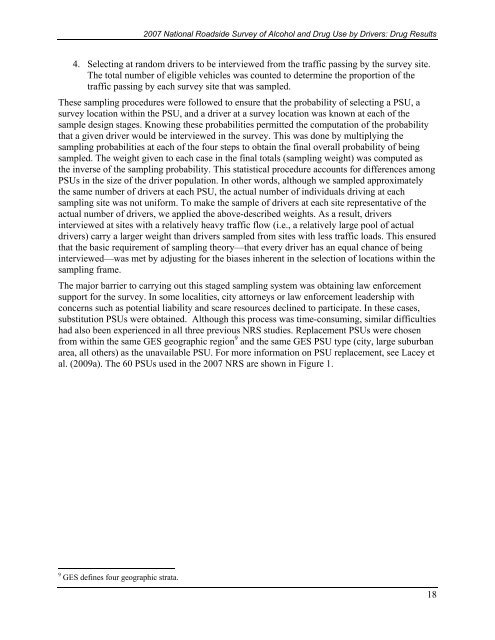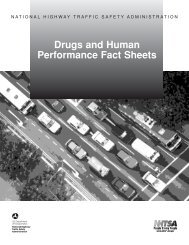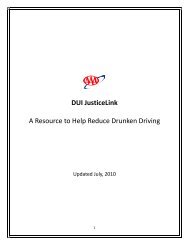2007 National Roadside Survey of Alcohol and Drug Use by Drivers
2007 National Roadside Survey of Alcohol and Drug Use by Drivers
2007 National Roadside Survey of Alcohol and Drug Use by Drivers
Create successful ePaper yourself
Turn your PDF publications into a flip-book with our unique Google optimized e-Paper software.
<strong>2007</strong> <strong>National</strong> <strong>Roadside</strong> <strong>Survey</strong> <strong>of</strong> <strong>Alcohol</strong> <strong>and</strong> <strong>Drug</strong> <strong>Use</strong> <strong>by</strong> <strong>Drivers</strong>: <strong>Drug</strong> Results4. Selecting at r<strong>and</strong>om drivers to be interviewed from the traffic passing <strong>by</strong> the survey site.The total number <strong>of</strong> eligible vehicles was counted to determine the proportion <strong>of</strong> thetraffic passing <strong>by</strong> each survey site that was sampled.These sampling procedures were followed to ensure that the probability <strong>of</strong> selecting a PSU, asurvey location within the PSU, <strong>and</strong> a driver at a survey location was known at each <strong>of</strong> thesample design stages. Knowing these probabilities permitted the computation <strong>of</strong> the probabilitythat a given driver would be interviewed in the survey. This was done <strong>by</strong> multiplying thesampling probabilities at each <strong>of</strong> the four steps to obtain the final overall probability <strong>of</strong> beingsampled. The weight given to each case in the final totals (sampling weight) was computed asthe inverse <strong>of</strong> the sampling probability. This statistical procedure accounts for differences amongPSUs in the size <strong>of</strong> the driver population. In other words, although we sampled approximatelythe same number <strong>of</strong> drivers at each PSU, the actual number <strong>of</strong> individuals driving at eachsampling site was not uniform. To make the sample <strong>of</strong> drivers at each site representative <strong>of</strong> theactual number <strong>of</strong> drivers, we applied the above-described weights. As a result, driversinterviewed at sites with a relatively heavy traffic flow (i.e., a relatively large pool <strong>of</strong> actualdrivers) carry a larger weight than drivers sampled from sites with less traffic loads. This ensuredthat the basic requirement <strong>of</strong> sampling theory—that every driver has an equal chance <strong>of</strong> beinginterviewed—was met <strong>by</strong> adjusting for the biases inherent in the selection <strong>of</strong> locations within thesampling frame.The major barrier to carrying out this staged sampling system was obtaining law enforcementsupport for the survey. In some localities, city attorneys or law enforcement leadership withconcerns such as potential liability <strong>and</strong> scare resources declined to participate. In these cases,substitution PSUs were obtained. Although this process was time-consuming, similar difficultieshad also been experienced in all three previous NRS studies. Replacement PSUs were chosenfrom within the same GES geographic region 9 <strong>and</strong> the same GES PSU type (city, large suburbanarea, all others) as the unavailable PSU. For more information on PSU replacement, see Lacey etal. (2009a). The 60 PSUs used in the <strong>2007</strong> NRS are shown in Figure 1.9 GES defines four geographic strata.18




